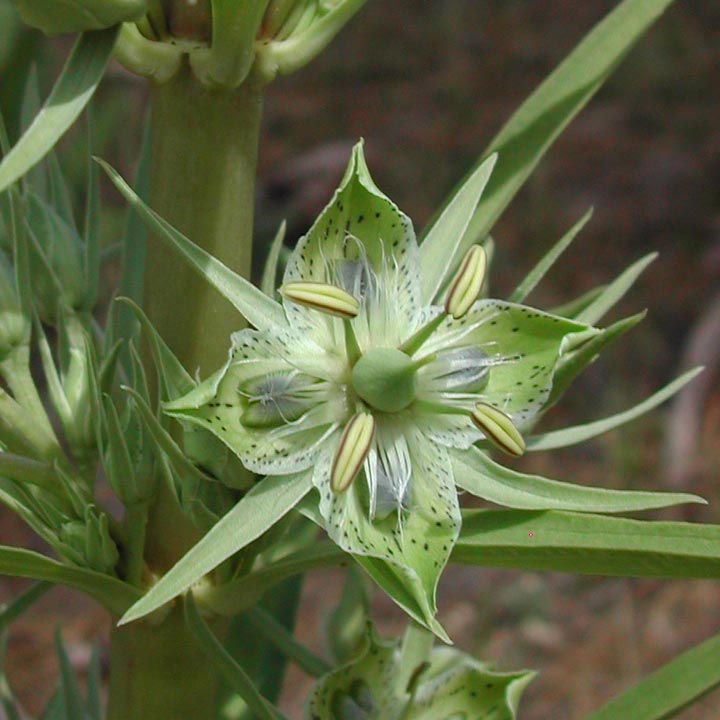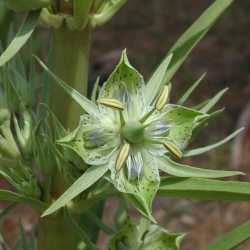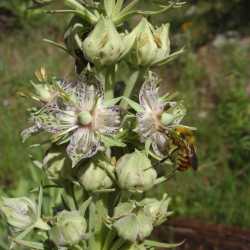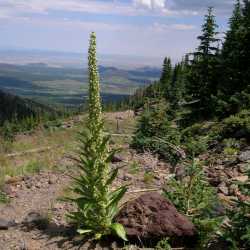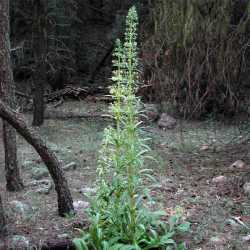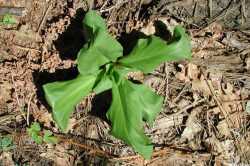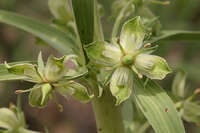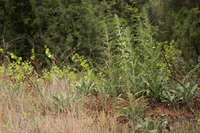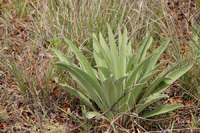Plant: perennial herb; thick tap root and enlarged caudex. STEMS to 2.5 m tall, minutely puberulent
Leaves: in a basal rosette gradually reduced to whorled and opposite bracts upward, the basal leaves 15-45 cm long, 2.5-15 cm wide, oblanceolate, the long attenuated base narrowing into a winged petiole
INFLORESCENCE: a compound cyme
Flowers: 4-merous; sepals nearly distinct, linear-lanceolate, 15-17 mm long; petals 1.5-2 cm long, 5-8 mm wide, elliptic, white to greenish, usually with dark dots, the nectar pits 2, parallel, ca. 7 mm long, 1-3 mm wide, each outlined with hairs; a fringed corona 5-10 mm long at the base of the petals; pistil 6-20 mm long at anthesis
Fruit: to 4 cm long, the style persistent. SEEDS dark brown, flattened, somewhat rectangular, 4-6 mm long, 2-3 mm wide, with a very narrow wing
Misc: Conifer forests or wet meadows; 1500-2900 m (5000-9500 ft); May-Sep
REFERENCES: Mason, Charles T. 1998 Gentianaceae. J. Ariz. - Nev. Acad. Sci. 30(2): 84.
Duration: Perennial
Nativity: Native
Lifeform: Forb/Herb
General: Erect stalk, foliage spreading at the base and tapering to a tip, leaves and flowers usually dense along the stem, stems stout, often only one stalk per thick tap root, can grow up to 2.5 m, puberulent.
Leaves: Long, blade-like leaves when plant is mature, arising from a basal rosette and becoming whorled, reduced bracts apically, basal leaves to 45 cm long and 15 cm wide, oblanceolate, borne on a short, winged petiole. Leafy basal rosette with leaves thin and having sinuous margins when immature.
Flowers: Light green with dark speckles, borne on a compound cyme up the length of the stalk, flowers 4-lobed with acute-tipped, linear lanceolate green sepals, elliptic to ovate green petals with acuminate tips, having 2 parallel, oval nectar pits, a white fringe protruding from the heart of the flower, pistil green, ovary superior, stamens 4, green, anthers yellow.
Fruits: Tulip shaped capsules, opening at the tips and bilaterally dehiscent, to 4 cm. Seeds, rectangular and flattened with a small wing, dark brown, 4-6 mm long.
Ecology: Found in wet areas in meadows and conifer forests, from 5,000-10,000 ft (1524-3048 m); flowers May-September.
Notes: This striking plant resembles a mullein at first, look for the large green buds and green flowers to differentiate. There is some debate as to the flowering habits of this plant, which can live up to 80 years and is thought to possibly flower only once before dying. Some believe that it can have more than one flowering cycle.
Ethnobotany: The roots were used to treat diarrhea, colds, stomach troubles, gonorrhea, and asthma, while a plaster of the leaves was used to treat headaches. An infusion of the whole plant was used to treat nervousness and anxiety, and was said to be useful as a life medicine and tonic. The ground plant was used to treat the incision made during the castration of livestock. The dried leaves were smoked along with mountain tobacco for confusion. A cold compound infusion was rubbed on hunters and their horses to lend strength and the long stalk was used to make elk calls during hunting. The roots were used as food and the nectar was used for honey.
Etymology: Swertia is named for Emanual Sweert a 16th century Dutch botanist, while speciosa means showy.
Synonyms: Frasera angustifolia, Frasera macrophylla, Frasera speciosa var. angustifolia, Frasers speciosa var. stenosepala, Frasera stenosepala, Swertia radiata, Swertia radiata var. macrophylla, Tesseranthium angustifolium, Tesseranthium macrophyllum, Tesseranthiu
Editor: LCrumbacher, 2011


